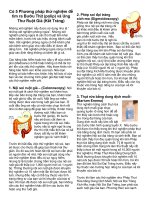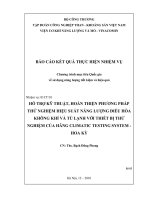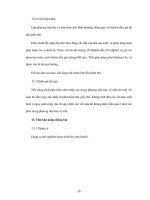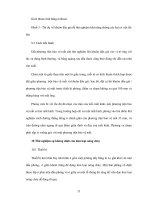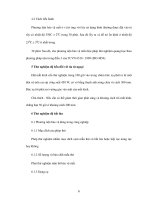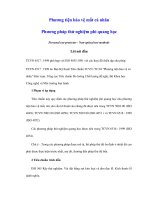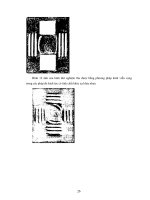Broch_WIT_SP-4504-e
Bạn đang xem bản rút gọn của tài liệu. Xem và tải ngay bản đầy đủ của tài liệu tại đây (767.95 KB, 8 trang )
Water Intrusion Test
Integrity Testing
Test description
Conventional integrity testing of
membrane filters using the bub-
ble point, diffusion or pressure
hold tests requires that the filter
membrane be completely wetted
with a suitable wetting agent.
Hydrophobic filter elements can
be tested by this method only if
the surface tension of the
wetting agent is less than the
critical surface tension of the
filter material being used. Other-
wise, complete wetting does not
take place.
This is why different organic
solvents like ethanol or solvent|
water mixtures are used as prac-
tical wetting media. This aspect is
especially detrimental when the
system is used as a “sterile air
filter" for venting tanks, bio-
reactors and fermenters .
Integrity testing of filters for liq-
uids is usually performed in situ.
However, the in situ integrity
testing of hydrophobic gas
filters is only possible to a limited
degree due to safety reasons (e.g.,
explosion protection when test-
ing with organic solvents) and to
keep the product from solvent
contamination. Besides these
complicated individual tests must
be followed by a drying phase
before any filter elements can
be installed.
Additionally the filter sealing in
the housing still has to be tested
in situ. Since the filters should be
retested immediately aher in-line
steam sterilization, tests with a
solvent|water mixture are
impractical for the user.
Moreover, the drying procedure
must be validated since solvent
residues can contaminate the
product if drying has been
insufficient.
The Water Intrusion Test (WIT)
was developed to overcome all of
these disadvantages. The WIT can
be used to run routine integrity
tests simply, easily and reliably.
Definition Water Intrusion
Test (WIT).
The Water Intrusion Test (WIT)
is an in-situ integrity test for
hydrophobic filters. The WIT
measures the decay rate of
a pressure level imposed upon
a hydrophobic membrane
enveloped in water.
Theoretical principles.
Among other things, a pressure
gradient that is dependent on
pore size is necessary to over-
come negative capillary forces
(cohesive forces). This pressure is
generally called the "Water
Penetration Point" (WPP), the
pressure at which water is
pressed through a hydrophobic
membrane. The WPP is depend-
ent on the hydrophobicity of the
filter material and the pore size
and is comparable to the bubble
point.
The relationship can be
illustrated as follows:
D
max
= Diameter of the largest
pore
σ
= Surface tension of the
liquid in dynes/cm
(water 72)
θ
= Angle of contact
(greater than 90° in
hydrophobic filters)
∆ p
= Available upstream
differential pressure
(bar|psi)
k
= Correction factor
(required since
membrane filter pores
are not cylindrical
capillaries)
Introduction
4 · σ· cosθ
D
max
=·k
∆ p
Intrusion (ml/10 min)
Test Pressure (bar)
350
300
250
200
150
100
50
0
0123456
Water Intrusion
Water Penetration
Water Intrusion Characteristics at Different Test Pressures
Pore Size: 0.2 µm, Height: 10’’, Temperature: 20°C
Principle of Water Intrusion Test
The Water Intrusion Test (WIT)
was developed as an integrity
testing method to test hydropho-
bic sterilizing grade filters. These
filters are often used as inlet air
and off-gas filters for fermenters
bioreactors and for venting
sterilizers, freeze dryers auto-
claves and tanks.
The WIT is employed in both the
qualification of filter elements
and as an inplace test procedure.
The WIT - like the mercury
intrusion test - is based on the
capillary depression of non
wetting liquids on the outer
surface of the membrane. To
withstand these capillary forces,
a certain pressure gradient,
which is dependent on the pore
size among other factors, is
necessary. The test run is in a
similar manner to the Diffusion
Test, although there is a major
difference. In the Diffusion Test,
the diffusive gas flow through a
wetted membrane is measured.
However, during the WIT a
hydrophobic filter installed in a
filter housing is flooded with
water on the upstream side.
The pressure drop detected by an
automatic integrity tester indi-
rectly measures the volume of
water intruding into the mem-
brane matrix. At first the test
system has to be flooded with
water, pressurised at the defined
test pressure and then stabilised
for a defined time. After the
stabilisation time
is complete, the
water intrusion
will be measured.
Origin of the pressure drop.
The pressure drop has two main
reasons:
1. The upstream volume is in fact
increasing due to remaining
compaction processes. Since
this compaction is an asymp-
totic process, it is never
absolutely completed. There-
fore, a certain time has to be
determined after which most
of the compaction is already
done. That is the main reason
for the stabilization time of
10 Minutes.
2. Water molecules actually get
transported through the mem-
brane. In case of an integer
membrane, this process is
mainly due to evaporation of
water molecules through the
pore structure. If the mem-
brane is punctured, water is
mainly flowing through the
punctured hole.
Water vanishes from the up-
stream side. The effect is, that the
upstream volume is increasing
(keep in mind that water is not
subject to compaction). This
amount of water (∆V) can be
determined using the fundamen-
tal law of Boyle and Mariott
(p
1
· V
1
= p
2
· V
2
)
Principle of WIT testing
compressed air|gas
p
1
p
2
V
1 ·
∆
p
(p
1
-
∆
p)
=
∆V
∆
t
V
n ·
∆
p
(p
1
–
∆
p)
·
∆
t
∆V = V
2
- V
1
= V
1
· - 1 =
with:
p
1
: Absolute pressure at the beginning of the pressure drop
measurement [mbar]
p
2
: Absolute pressure at the end of the pressure drop measurement
[mbar]
∆p: = p
1
- p
2
V
1
: Upstream Volume at the beginning of the measurement [ml] (= V
n
)
V
2
: Upstream Volume at the end of the measurement [ml]
The increase in Volume per time is defined as:
This value is defined – as one easily understands – as the “Water Flow
Value”. This value is basically linked to the Water Intrusion Value by a
simple mathematical correlation:
The Water Intrusion is a value that has been defined in analogy to the
diffusion. For small pressure drops (< 5% of the absolute test pressure),
the following equation holds:
with:
V
n
: Upstream Volume [ml]
∆p: Pressure Drop [mbar]
1000 mbar: Reference Pressure
∆t: measurement duration [min]
Physically, air molecules pass through the wetted membrane. If one
collects all these molecules, they will fill a certain volume at 1000
mbar reference pressure at the ambient temperature as reference
temperature. This volume pre time is the Diffusion value.
The Water Intrusion is calculated using the same formula:
If one imagines the volume ∆V that has been added to the upstream
Volume due to the Water Flow to be filled with gas, it would use a
different volume at an ambient pressure of 1000 mbar. Again, the
required volume at 1000 mbar (∆V10OO) can be calculated with Boyle
Mariott's law to be:
∆V
∆
t
V
n ·
∆
p
(p
1
-
∆
p)
·
∆
t
WIT = · =
·
=
p
1 -
∆
p
1000 mbar
(p
1 -
∆
p)
1000 mbar
V
n ·
∆
p
1000 mbar
·
∆
t
Diff. =
V
n ·
∆
p
1000 mbar
·
∆
t
WIT =
V
n ·
∆
p
1000 mbar
·
∆
t
∆V
1000
= ∆V·
(p
1 -
∆
p)
1000 mbar
Test parameters
Practical aspects Water
Intrusion Test.
• Allows inplace testing after
sterilization
• Avoids using wetting agents,
e.g. IPA/Water
- Therefore no contamination
- No removal problems
No alcohol residue or down-
stream contamination
• The hydrophobicity of the
filter stays hydrophobic during
the test
• High sensitivity of the test
• The hydrophobicity of the filter
is evaluated by the test
• The time is reduced, especially
at multiple systems, which
reduces the shut down periods
• Directly correlated to the ASTM
Bacteria Challenge Test.
System set-up.
The WIT can be used in a variety
of air filtration applications that
require minimal engineering
changes, however, some times
systems may have to be reconfig-
ured. This is where the Sartorius
Technical Support team comes to
your assistance.
The diagram to the right shows
an example of a manual WIT sys-
tem. The basic construction does
not differ significantly from that
used for the diffusion test. In
principle, WIT systems can be
designed as manual, semi-auto-
matic and fully automatic units
to suit the applications, e.g.,
sterile venting systems for auto-
claves, Iyophilizers, fermenters
and tanks.
Basic requirements for the
test are:
1. The surface tensions of the
water used must be > 72
dynes/cm.
2. Minimized temperature differ-
ence between the water and
the inlet air ± 1k.
3. Temperature fluctuations must
be avoided during the test.
4. Filter element must be com-
pletely hydrophobic.
5. Adequate effective filter area,
i.e., > 0.1 m
2
.
6. The integrity tester must have
sufficient accuracy, e.g.,
Sartocheck
®
unit.
Operating sequence:
1. Completely fill the upstream
side of the filter housing with
water.
2. Close all upstream valves.
3. Connect the integrity tester,
e.g., Sartocheck 3 unit.
4. Start the test: The unit per-
forms the WIT automatically.
5. The test is completed and the
results are printed out.
6. Empty the filter housing
through an appropriate drain
or condensate valve.
7. Briefly vent dry using pressu-
rized air with the inlet and
drain valves open.
8. Start operating the system.

